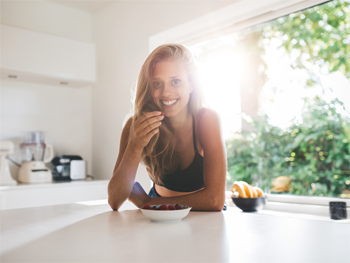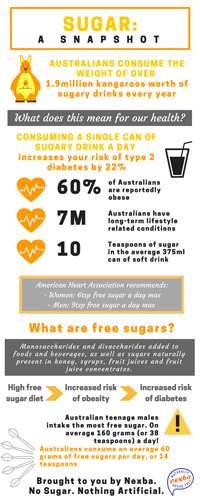7 Tips To Help You Decode Labels To Identify Hidden Sugars

The Bittersweet Truth about Food and Beverage Labelling
Sugar has been under the spotlight in recent years, with growing evidence demonstrating that we live in a world addicted to the sweet stuff.
On the home front, according to the ABS, Australians consume an average 60 grams of free sugars per day (or 14 teaspoons), and over half of these sugars are consumed from beverages – such as soft drinks, energy and electrolyte drinks, fruit juices and fruit drinks, and cordials. To put that in perspective, the recommended maximum daily intake is 9 teaspoons for the average adult.
Australian teenage males have the highest intake of free sugars across all age groups, consuming 160 grams (or a massive 38 teaspoons) of free sugars per day.
Within Australia, Diseases such as obesity are projected to accumulate $87.7b in direct and indirect costs between 2015 to 2025, with long term lifestyle related conditions affecting almost 7m Australians.
There is also a strong correlation between processed or 'free sugar' consumption and obesity.
Free sugar, as defined by the World Health Organisation, are "monosaccharides and disaccharides added to foods and beverages, as well as sugars naturally present in honey, syrups, fruit juices and fruit juice concentrates". This doesn't include naturally occurring sugars in fruits and vegetables, or sugars that are intrinsic to the food.
 The Critical Role of Labelling
The Critical Role of Labelling
A lack of transparent nutrition and ingredient labelling plays a huge role in impacting on consumer healthy food and beverage choices. "While consumers have a responsibility for their health, they also need access to 'real' facts in order to make informed lifestyle choices, especially when walking down the shopping aisle," said Drew Bilbe, Co-Founder and CEO of Nexba Beverages.
Ingredients must be listed on the nutrition information panel in descending order, with the first ingredient on the list containing the most amount of weight in the food. "So if sugar is listed as one of the top 3 ingredients, you may want to put that item back or consume it only sparingly," said Mr Bilbe.
WHO recommends that less than 10 percent of our daily energy intake come from free sugars, for both children and adults - equivalent to 12 teaspoons. "What is misleading about sugar information on food and beverage labels is that only the total amount of sugar is listed, but sugars that have been added to the product by the manufacturer are not differentiated from sugars that are intrinsic to the food" said Mr Bilbe.
Sugar also goes by many names. According to the University of California San Francisco (UoCSF), there are at least 61 names for sugar, with some of the most obvious being cane sugar, coconut sugar, corn syrup, glucose and fructose. Some of the lesser known names are dextrin, dextrose, maltose and invert sugar.
7 Tips to Help You De-mystify Labels
The next time you are at the supermarket doing your weekly shop, here is a helpful checklist families can use before unknowingly buying, or over-consuming, any unnecessary sugars or other nasties:
Be savvy on the guidelines: Ingredients are listed in order of weight so if sugar is in the top 3 ingredients you may want to reconsider. The label will also show the amount of sugar per serve and per 100g. The American Heart Association recommends no more than 36g of added sugar for men and 25g for women. "It's ideal to look at the whole picture rather than just one ingredient in the product, such as sugar. As you do this, compare different brands of the same food type to determine the healthiest option," says Mr Bilbe.
Don't take labels at face value: When reviewing the sugar content also check for any curious ingredients. A quick google search will help. Also know that if you buy any foods or beverages that look processed to some degree, such as a standard muffin or fruit drink, assume that the sugar content has 'free' sugars in it, and account for these in your daily dietary intake if you do decide to buy.
Beware of sneaky sugars: A common sweetness enhancer is sucrose, which contains both disaccharides and monosaccharides. While it is produced naturally in plants – typically extracted from cane sugar – it is commonly refined for use in food items such as table sugar. The other sugar to avoid is high fructose corn syrup (HFCS), which is a sweetener made from corn starch or maize that has been processed with some of its glucose converted into fructose.
"While fructose or fruit sugar is found intrinsically in fruits and vegetables, as well as honey, it's a good idea to be mindful of added fructose to processed or packaged foods, as this will load up your free sugar calories," adds Mr Bilbe.
If in doubt don't buy: If you can't put a 'real' name to an ingredient or if you intuitively feel that the ingredient might not be healthful, the best advice is don't buy it. This is a good rule to follow if you're serious about your health and keeping the lid on sugar.
Sugar free is not enough: Sugar-free options often replace sugar with artificial alternatives that have their own side effects and can at times be worse. Look out for products which are labelled as 'Naturally Sugar Free' and/or contain obviously natural ingredients. You will often find natural alternatives to your favourite sugar-fuelled products are more readily available than you think. Common soft drinks can contain your entire daily sugar allowance, swap these out for alternatives such as Nexba Cola which contains no sugar and nothing artificial, but still delivers an authentic cola taste.
Experiment with natural alternatives: If you enjoy a hint of sweetness, some of the healthiest options to choose from include organic or raw honey straight from the source or cacao, which is a pure and raw form of chocolate – cacao nibs can be especially tasty when added to hot beverages or to your morning oats. Cacao also has a number of beneficial phytonutrients, such as flavonoids which contain antioxidants and anti-viral properties.
Know the jargon: Common health claims can be meaningless unless you know the facts behind them. For example, low fat means this food must have 3g of fat or less per 100g but look at the label because it may be high in sugar instead.
MORE



